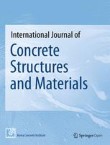International Journal of Concrete Structures and Materials is affiliated with Korea Concrete Institute.
Prediction of Shear Strength for Large Anchors Considering the Prying Effect and Size Effect
An anchorage system is necessary in most reinforced concrete structures for connecting attachments. It is very important to predict the strength of the anchor to safely maintain the attachments to the structu...
